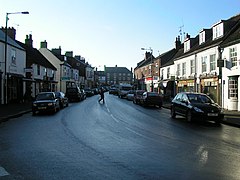Boroughbridge
| Boroughbridge | |
|---|---|
 Boroughbridge high street | |
| Population | 3,210 |
| OS grid reference | SE393668 |
| District | |
| Shire county | |
| Region | |
| Country | England |
| Sovereign state | United Kingdom |
| Post town | YORK |
| Postcode district | YO51 |
| Dialling code | 01423 |
| Police | North Yorkshire |
| Fire | North Yorkshire |
| Ambulance | Yorkshire |
| UK Parliament | |
Boroughbridge is a small town and civil parish in the Harrogate district of North Yorkshire, England. It is situated 13 miles (21 km) northwest of York. Until its bypass was built, it was on the main A1 road from London to Edinburgh. The A1 crosses the River Ure here.
Origin of the name
Traditionally the origin of the name 'Boroughbridge' lies in its location relative to the nearby town of Aldborough. Aldborough was the principal town in the area during the Roman period, known then as Isurium Brigantum. After the Norman Conquest it appears that the crossing of Dere Street (the Roman Road heading to the North from York) over the Ure was diverted from just north of Aldborough to its present position in the town of Boroughbridge.
A new town grew up around this crossing and, whilst the Old Town became known as the 'Ald-Borough' (Hence Aldborough), the New Town became 'New Borough on t'Brigg' (Brigg being Bridge), which naturally became 'Borough on t'Brigg' and finally Boroughbridge.
History
A line of three menhirs, or standing stones, known as The Devil's Arrows, believed to have been erected in the Bronze Age, can be found on the outskirts of Boroughbridge, just by the side of the A1. The tallest stone is 6.8 metres (22 ft) tall. The stones are of millstone grit, probably quarried from nearby Plumpton, the closest source of this material.
The stones stand on an almost North - South alignment, with the central stone slightly offset.
Historically there were certainly more stones. The first reference to them is from the journal of a Fisherman named Peter Frankck who visited Boroughbridge in 1694, and claims he saw 7 stones. The famous antiquarian John Leyland (Sometimes incorrectly spelt John Leland) saw four stones, which is the verifiable number. The (now absent) fourth stone stood close to the central stone and was dug out and broken up, allegedly by treasure hunters. Most of it was used to build the bridge in Boroughbridge called Peg Bridge, which crosses the river Tutt as it enters the town.
According to tradition the top of this fourth stone was to be found in the grounds of Aldborough Hall, which stands between Boroughbridge and Aldborough.[1]
In 1322, the Battle of Boroughbridge took place as King Edward II overpowered Thomas, Earl of Lancaster, bringing about the end of Edward II's retaliation against those who had opposed him in the Despenser War of 1320-1321.
Boroughbridge was a parliamentary borough from medieval times, electing two Members of Parliament to the unreformed Commons. It had a "burgage" franchise, meaning that the right to vote was tied to ownership of certain pieces of property in the borough, and it had less than 100 qualified voters by the time it was abolished in the Reform Act of 1832: It was a pocket borough entirely under the control of the Dukes of Newcastle. Augustus FitzRoy, who was later Prime Minister as the 3rd Duke of Grafton, was elected MP for Boroughbridge in 1756; however, he never sat for the borough as he preferred to represent Bury St Edmunds where he had also been elected.
In the days of stagecoaches, Boroughbridge was an important stage, thanks to its position on the Great North Road midway between London and Edinburgh. An advertisement in the Edinburgh Courant for 1754 reads:
The Edinburgh Stage-coach, for the better accommodation of passengers, will be altered to a New Genteel Two-end Glass Coach Machine, being on steel springs, exceeding light and easy, to go in ten days in Summer and twelve in Winter; to set out the first Tuesday in March, and continue it, from Hosea Eastgate's, the Coach and Horses, in Dean-Street, Soho, London; and from John Somerville's, in the Canongate, Edinburgh, every other Tuesday, and meet at Burrow-Bridge on Saturday night, and set out from thence on Monday morning, and get to London and Edinburgh on Friday. In Winter, to set out from London to Edinburgh every other (alternate) Monday morning, and to go to Burrowbridge on Saturday night; and to set out from thence on Monday morning, and get to London and Edinburgh on Saturday night. Passengers to pay as usual. Performed, if God permits, by your dutiful servant HOSEA EASTGATE.

In 1945 the A1 bridge over the River Ure collapsed under the weight of a heavy transport vehicle carrying an 80-ton steel mill roll housing from Sheffield to Falkirk. That interrupted a main transport route only for a short while, the Army installing a Bailey bridge until repairs were completed.
Present day
Boroughbridge has both a primary school and a high school. Boroughbridge High School specialises in performing arts and has a library, computer rooms and a drama studio. It celebrated its 25th anniversary in the summer of 2007.
Close to Boroughbridge is the village of Aldborough, once the site of the Roman settlement Isurium Brigantum (SE406664). There is a small museum.
Library
Boroughbridge library is under threat from spending cuts. To stop it from being run by volunteers or from being closed, search for a petition online named 'Save Boroughbridge library'.
Location grid
See also
References
- ^ Richmondshire and the Vale Of Mowbray, Edmund Bogg, Published by Elliot Stock 1908, Vol. 1 pp. 8–12
